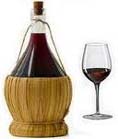Drinking Glasses - 2
from Italian Traditional Food
More about drinking glasses
Check out these great Italian ideas at Amazon for Italian food and kitchen ideas.
<<
Previous Page
2
Continuing the short history of drinking glasses
But the character of English drinking glasses
changed after a heavy tax by weight was imposed in 1745 (to help pay for the French Wars), and lighter glasses
became valued for their delicate cutting and engraved patterns. So decorated glassware sprang to the fore during
the latter half of the 18th century.
New Fashions
The new, lighter glass was clearer, thinner and more "watery" in appearance, a nearer
approximation to the original Venetian "cristallo", and it lent itself well to cutting and engraving. This new
glass was also properly annealed by long, slow cooling and therefore less likely to shatter on the cutter's wheel.
The earliest cuts were diamond-shaped or shallow hexagons on the stems. Soon, fluted cutting appeared round the
feet, and the bowls themselves came under attention. It was not uncommon for owners of the old, plain glass shapes
to take them to be cut or engraved in the latest fashion. Shallow cuts became deeper after 1780, particularly on
the heavier Anglo-Irish glass produced at the turn of the century.
Wheel-engraving
Then wheel-engraving became an art-form, the earliest designs being predictably of hops, barley
and vines. Burt a fascinating earlier category of wheel-engraved glasses are those bearing the symbols and slogans
of the Jacobite cause. Numbers of these have survived for collectors, bearing roses with one or two buds -
symbolising the Old Pretender and his son, Prince Charles Edward - and other common symbols such as the oak leaf,
stricken oak, star, thistle and various Latin inscriptions from "Redeat" (May he return) to "Fiat" (So be it).
Later, engraved forget-me-nots reflected the dying hopes of his supporters.
From 1800-1830, plain drinking glasses continued to be used in taverns,
while more elaborate wares graced the home, Initials and coats of arms appeared more and more on wineglasses, the
most popular shape being a variation of the "rummer". Made originally for Rhenish wines, it had a wide, spherical
bowl and shortish stem, and very large ones or "Constables" were made for dispensing quantities of punch at thirsty
gatherings.
Page 1 of this article on drinking glasses can be found on
the previous page.
<<
Previous Page
2
Read more Italian traditional food
related articles here

Copyright © 2009 -
. All Rights Reserved Worldwide. Italian Traditional Food
You may not reprint articles from this website
without the written permission of the site owner.
Disclaimer: Articles on this
Website are provided for information purposes only. Italiantraditionalfood.com does not accept any responsibility
or liability for the use or misuse of the article content on this site or reliance by any person on the site's
contents.
| 


 Digg
Digg Stumbleupon
Stumbleupon Google Bookmarks
Google Bookmarks Delicious
Delicious Twitter
Twitter Facebook
Facebook Yahoo My Web
Yahoo My Web Reddit
Reddit